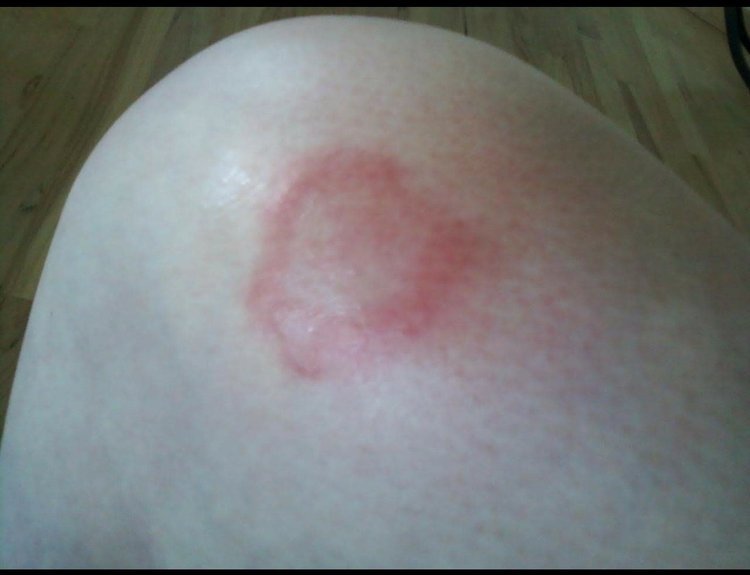Lyme Disease Bullseye Rash
(Erythema Migrans)
Less than 50% of people with Lyme experience a rash.
An early sign of Lyme disease is a skin rash that has a "bull's eye" appearance also called a erythema migrans. The Lyme Disease Bullseye Rash begins as a reddened area near the tick bite. As the rash increases in size, it clears in the middle and develops a red ring around the outside. It should be noted that the bullseye bite mark may not appear where the tick was attached.
As with any multi-systemic infectious disease, our skin, being our largest organ, it can be affected in many ways. It holds us together, and is our first line of defense, against disease, and outside forces such as heat, and cold. This is why, with many diseases, our skin is the first to show us signs that something is not right inside of our bodies.
Important Steps to Take After Seeing a Lyme Disease Bullseye Rash or a erythema migrans
Take pictures daily and date them (especially helpful if you are not able to get into a doctor right away)
Circle the rash in the early stages with a pen or permanent marker to track the growth.
Keep a symptom journal noting any flu like symptoms, fatigue, headaches, joint pain, and any other symptoms you are experiencing that are not normal for you. Take this with you to your appointment.
Be persistent with your doctor. It is not uncommon for a doctor to brush off the possibility of Lyme Disease even with the Bullseye rash. The rash is a telltale sign of infection, so be persistent and find another doctor if you need to. If it is in fact Lyme Disease, early treatment is crucial.
Lyme Disease Bullseye Rash
Most people associate the "bulls-eye" rash, or "Erythema migrans" rash with Lyme Disease. Although it is a clear sign of infection, it may not be noticed due to its location on the body, may appear as a different shape, or may not appear at all. Leaving us to guess when asked by our doctors, if we have ever noticed a rash, and what it looked like. Many times, even if we arrive at the office with a bright red bulls-eye on our leg it is not treated or given an ineffective dose of antibiotics. Leaving Lyme Disease, and probable co-infections to go untreated in the body.
The Lyme Disease Bullseye Rash: (Ref:Lyme Disease Rashes - MN Dept. of Health (state.mn.us))
May expand to a very large size.
Is usually not painful or itchy.
Often appears on the thighs, groin, trunk and armpit.
The rash has been reported in about 50 percent of Lyme disease cases.
Not everyone with Lyme disease gets the rash.
Sometimes the rash does not have a bull's eye appearance. It may appear as a reddened area without an outer ring.
The Lyme disease rash is not transmitted from person to person.
What does a Bullseye Rash Look like? What does a erythema migrans rash look like?
It begins as a reddened area near the tick bite. As the rash increases in size, it often clears in the middle and develops a red ring around the outside, so that it has a “bull's eye” appearance.
The picture below demonstrates how the bullseye rash can appear in other form. (Ref: Lyme MD poster final 3 (maryland.gov))
DISCLAIMER: THIS WEBSITE DOES NOT PROVIDE MEDICAL ADVICE
The information, including but not limited to, text, graphics, images and other material contained on this website are for informational purposes only. No material on this site is intended to be a substitute for professional medical advice, diagnosis or treatment. Always seek the advice of a qualified health care provider with any questions you may have regarding a medical condition or treatment and before undertaking a new health care regimen, and never disregard professional medical advice or delay in seeking it because of something you have read on this website.
Lyme Disease Rashes and Other Related Rashes: Frequently Asked Questions
What is a Lyme Disease bullseye rash?
A Lyme disease rash, also known as erythema migrans (EM), is a characteristic skin rash that often appears in the early stages of Lyme disease. It typically starts as a small red bump or a flat, circular rash that expands over time, resembling a bull's-eye pattern. The rash may or may not be itchy or painful. It can also appear any where on the body, not just at the bite site.
How soon after a tick bite does a Lyme disease rash typically appear?
The Lyme disease rash usually appears within 3 to 30 days after a tick bite, with the average time being around 7 to 14 days. However, it's important to note that not all Lyme disease cases present with a rash, and some people may develop other types of rashes associated with tick-borne infections.
Are there other rashes associated with tick-borne infections besides Lyme disease?
Yes, there are other rashes associated with tick-borne infections. Some of these include:
Bartonella Rash: Bartonella infection, also known as cat-scratch disease, can cause red, raised bumps or papules or scratches from infected animals.
Babesia Rash: Babesiosis, a parasitic infection transmitted by ticks, may cause a range of rashes, including maculopapular rashes, petechial rashes (tiny red spots), or a rash similar to Lyme disease's erythema migrans.
Rocky Mountain Spotted Fever Rash: Rocky Mountain spotted fever, caused by the bacterium Rickettsia rickettsii, produces a rash that typically starts as small, flat, pink spots that later develop into a red, spotty rash on the wrists, forearms, ankles, and soles of the feet.
Anaplasma Rash: Anaplasmosis, caused by the bacterium Anaplasma phagocytophilum, does not usually produce a distinctive rash. However, some individuals may experience a maculopapular rash or red patches.
Do all tick-borne infections exhibit a rash?
No, not all tick-borne infections exhibit a rash. While a rash is a common symptom of Lyme disease, other tick-borne infections may not always present with a rash. It's important to be aware of the wide range of symptoms associated with different tick-borne illnesses and consult a healthcare professional if you suspect you may be infected.
Does erythema migrans always mean Lyme disease?
No, not all tick-borne infections exhibit a rash. While a rash is a common symptom of Lyme disease, other tick-borne infections may not always present with a rash. It's important to be aware of the wide range of symptoms associated with different tick-borne illnesses and consult a healthcare professional if you suspect you may be infected.
How long does the Lyme Disease bullseye rash last?
The duration of rashes associated with tick-borne infections can vary. In Lyme disease, the erythema migrans rash often expands over several days or weeks and can persist for several weeks before fading. Rashes associated with other tick-borne infections may also last for varying durations, depending on the specific infection and individual response to treatment.
Can a Lyme Disease bullseye rash be itchy or painful?
Yes, these rashes can be itchy or painful, although the severity of symptoms may vary among individuals. It's important to note that tick-borne infection rashes can have different characteristics, and not all rashes associated with tick bites are caused by Lyme disease.
What should I do if I develop a rash after a tick bite or suspect a tick-borne infection?
If you develop a rash after a tick bite or suspect a tick-borne infection, it's recommended to seek medical attention. Contact a healthcare professional who is knowledgeable about tick-borne illnesses for an evaluation, diagnosis, and appropriate treatment. If your doctor does not listen to your concerns, find another doctor.
Does a Bullseye Rash always mean Lyme Disease?
The bullseye rash is a telltale sign of an infection, usually associated with Lyme Disease. However, a similar appearing rash can be indicative of allergies, ringworm and other infections. It is imperative to speak with your doctor about a recent tick bite or recent exposure to ticks should you notice a bullseye rash.


